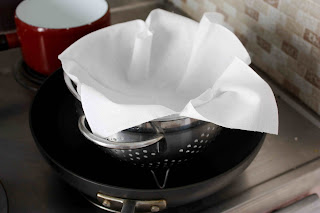After a bit of a hiatus from the blogosphere, which may be extended due to other commitments, I want to share a really tasty recipe that brings back to me vivid memories of Japan. In Japan there is a kind of yellowtail fish called buri, which, oddly enough, I seem to remember being introduced to in Bien Hoa, Vietnam, about fifteen years ago -- impossible, probably, and yet whenever I have buri I flash back to the Vietnamese countryside and the woman at the campus canteen with whom I had a meal plan of sorts. Maybe I'm finally losing it...
In any case, buri to daikon no nimono is a great recipe for any time of the year, but it's particularly an excellent wintertime dish. Perhaps I say this because I remember having it in Japan as snow drifted past the windows like pure white macaroons, and to keep warm everyone huddled around the kotatsu surrounded by cups of hot sake. There's really no better atmosphere for this dish, but hey, we can't always be so lucky, right?
This is truly an amazing dish. The daikon becomes tender with cooking, absorbing the mix of flavors like nothing else can, and pairs extraordinarily with the sweet, deeply flavorful yellowtail. This is also one of those dishes that tastes even better on the second day, after the daikon has had additional time to be transformed by absorbing more of the sauces and yellowtail juices.
Ingredients
3 yellowtail (buri) fillets
2 medium daikon
4 slices ginger root
Salt
Water from washed rice
Ginger, cut into long strips
Mitsuba leaves (Japanese parsley), chopped
Sauce #1
1 teaspoon dashi powder
1/2 cup sake
3 tablespoons mirin
3 tablespoons soy sauce
2 tablespoons sugar
Sauce #2
1/2 cup sake
2 tablespoons mirin
2 tablespoons soy sauce
1 tablespoons sugar
Directions
1. Cut fish into large bite-sized pieces. Salt pieces lightly on both sides and let sit for 30 minutes.
2. Pour boiling water over fish, then rinse with cold water.
3. Peel daikon. Cut into 1 or 2 cm wedges. Boil in enough water (from the washed rice, preferably) to cover daikon, adding a tablespoon of rice if you'd like, for 15 minutes. After boiling, drain daikon. Let it cool, then pat dry with paper towel.
4. Pour into a pot the sliced ginger and sauce #1 and bring to a boil. Add fish and cook for 15 minutes.
5. Add sauce #2 and simmer for 5 minutes.
6. Add daikon. Cook on low heat for 30 minutes or until light brown. (At this point, taste the daikon to make sure it has absorbed the cooking flavors.)
7. Serve with ginger strips and chopped mitsuba.

























